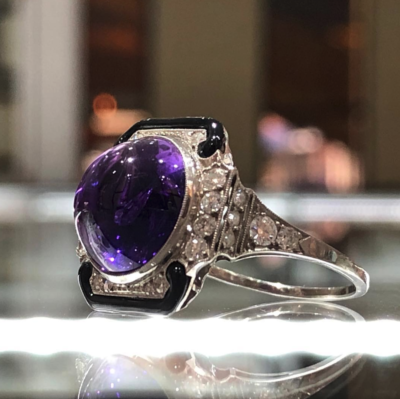Revealing the Rich Background Behind Exquisite Estate Jewelry Pieces
The exploration of exquisite estate jewelry pieces introduces a rich tapestry of background, mirroring the social values and imaginative motions of their time. As we analyze the elaborate details and provenance of these pieces, one must consider the profound tales they hold-- stories that might challenge our understanding of beauty and importance in the world of jewelry.
The Beginnings of Estate Jewelry
The beginnings of estate fashion jewelry can be traced back several centuries, mirroring a rich tapestry of social and historic impacts. At first, jewelry worked as a symbol of wealth and status among aristocrats and nobility. As different civilizations arised, unique styles and techniques advanced, usually intertwined with the customs and beliefs of their corresponding societies.

As cultures proceeded, estate precious jewelry began to stand for greater than simple adornment; it became a form of personal expression, with pieces commonly gave with generations. This transfer of possession imbued each item with tales and memories, further boosting its worth. Hence, estate precious jewelry encompasses a myriad of influences, enveloping the significance of human experience, virtuosity, and history, making it a considerable facet of the jewelry world today.

Noteworthy Historic Periods
Throughout history, numerous periods have dramatically influenced the design and relevance of estate precious jewelry. Each duration yielded one-of-a-kind designs, products, and social contexts that formed the creativity of jewelry-making.
The Victorian age (1837-1901) noted a profound shift in fashion jewelry style, identified by charming motifs and detailed craftsmanship. During this time, fashion jewelry often represented individual view and was frequently utilized to celebrate significant life events. The Art Nouveau activity (1890-1910) followed, highlighting organic types and flowing lines, drawing ideas from nature and the human number.
The Roaring Twenties declared the Art Deco period (1920-1939), renowned for its geometric shapes, vibrant colors, and a feeling of modernity. This period mirrored the pep of allure Age and the wish for deluxe and luxury. Adhering To The Second World War, the Mid-Century Modern era (1945-1960) welcomed simpleness and capability, showcasing clean lines and ingenious materials.
Each of these historic periods has actually left an enduring mark on estate jewelry, not only in regards to aesthetic charm however also in the way these items reflect the social values and technical improvements of their time.
Iconic Layout Features
Often, iconic style qualities of estate precious jewelry reveal a rich tapestry of social impacts and artistic motions. estate jewelry austin. Each piece offers as a visual narrative, showcasing the stylistic preferences of its period and the craftsmens' proficiency. As an example, the elaborate lacework job common in Victorian precious jewelry exhibits the duration's attraction with nature and love, frequently including themes such as flowers and leaves.
The Art Nouveau activity introduced streaming lines and natural types, highlighting the elegance of natural environments. In comparison, the bold geometric patterns of Art Deco jewelry mirror the modernist ethos of the 1920s, identified by proportion and a focus on commercial materials.
Additionally, making use of dynamic gems and ingenious methods, such as enameling and pavé setups, additionally identifies these pieces. Shade combinations frequently correspond to specific social contexts, with certain stones representing riches or visit this site condition.
Famous Estate Fashion Jewelry Pieces
Estate fashion jewelry encompasses a variety of distinguished items that have gone beyond time, each informing an one-of-a-kind tale of its beginning. Among these, the "Napoleon Ruby Locket," originally crafted for Empress Josephine, exhibits luxury with its intricate design and historical importance. An additional iconic piece is the "Cartier Panther Arm Band," which showcases the famous panther theme that has ended up being synonymous with the Cartier name, mixing creativity with a bold declaration.
The "Bulgari Serpenti" collection, with its sinuous, snake-inspired layouts, has actually mesmerized enthusiasts because the mid-20th century, representing high-end and allure. Additionally, the "Maharaja Necklace," adorned with a captivating variety of gemstones, shows the grandeur of Indian royalty and the rich cultural heritage connected with estate jewelry.

The Value of Provenance
Provenance plays a critical function in establishing the value of estate fashion jewelry, as it offers a documented history that boosts the piece's relevance and desirability. A thing with a you could look here well-documented family tree commonly commands greater prices due to its organization with noticeable figures, historical occasions, or creative activities. Collection agencies and investors alike are attracted to items that inform a story, as these stories include layers of meaning beyond mere visual appeals.
The verification of provenance can entail different kinds of documentation, such as original purchase receipts, appraisals, and exhibition records. Furthermore, narrative histories passed down via family members can contribute to the story, enhancing the allure of the fashion jewelry (estate jewelry near me). The more legitimate and comprehensive the provenance, the more probable it is to stand out in the market
In addition, provenance can reduce issues concerning authenticity; items with established histories are less most likely to be considered as reproductions or phonies. In this method, provenance not just raises the intrinsic worth of estate precious jewelry yet additionally safeguards the collector's financial investment. Eventually, a compelling provenance changes a piece from a plain things into a cherished artefact Related Site of history, making it a desired addition to any collection.
Conclusion
The expedition of estate fashion jewelry reveals a profound connection between artistry and historical context. Inevitably, the rich narratives behind estate precious jewelry not just celebrate specific artistry but likewise envelop the broader tapestry of human history and social advancement.